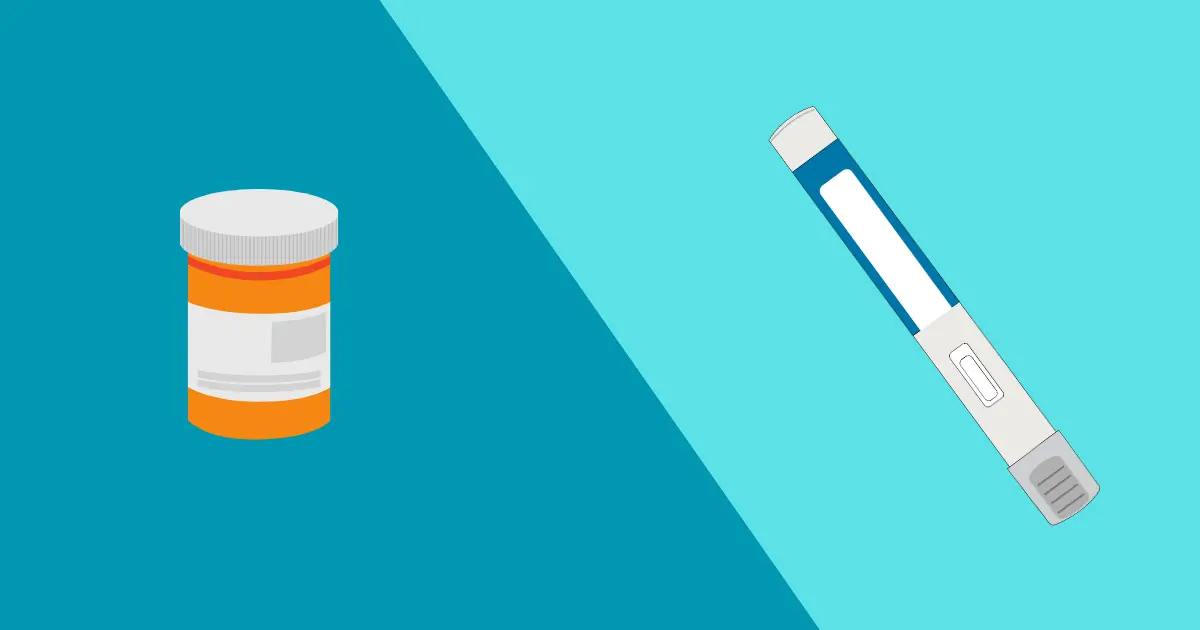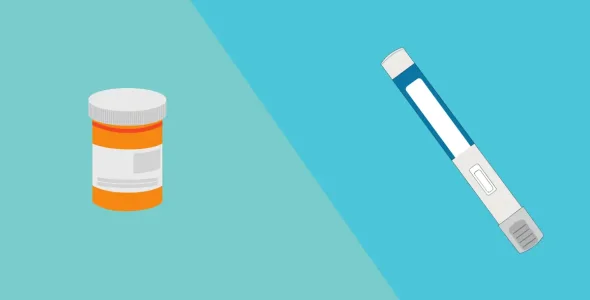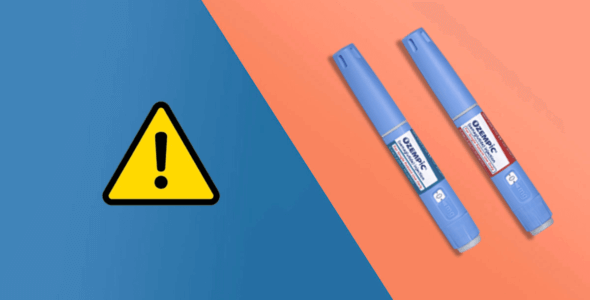Contrave vs. Ozempic: A head-to-head comparison for weight loss
Trying to choose between Contrave and Ozempic for weight loss? These two popular medications work in completely different ways. Let's break down the science, side effects, and real-world results so you can make the right choice for you.
Key highlights
- Contrave is a weight loss medication with two active ingredients, naltrexone and bupropion. It can help you lose weight when used along with a healthy diet and regular exercise.
- Ozempic (semaglutide) is an FDA-approved once-weekly injection for type 2 diabetes in adults.
- Contrave targets brain pathways to reduce cravings. Ozempic mimics a gut hormone to increase fullness and slow digestion.
- Ozempic leads to greater weight loss, while Contrave may be more effective for emotional or reward-driven eating.
- Ozempic helps manage type 2 diabetes and reduces cardiovascular risk. Contrave may offer mood-related benefits.
- Both medications require lifestyle changes and regular medical supervision for optimal results.
- The right choice depends on your health profile, preferences, and long-term weight loss goals.
The growing obesity medication landscape includes GLP-1 agonists like Wegovy and Ozempic, combination drugs like Contrave and Qsymia, and newer drugs like Zepbound, which can lead to up to 20% weight loss. Options vary in effectiveness, side effects, and suitability based on individual health needs and goals.
Contrave (naltrexone and bupropion) is an oral combination medication that targets brain pathways involved in cravings and reward. Ozempic (semaglutide) is a once-weekly injectable GLP-1 receptor agonist originally approved for type 2 diabetes. Despite different primary indications, both are used to support weight management, helping individuals reduce appetite and improve control over eating.
With both drugs offering unique benefits, a direct comparison helps clarify which option may better support sustainable, effective weight management.
Choosing between Contrave and Ozempic is a complex and significant decision that should consider individual factors like your medical history, lifestyle, treatment goals, and how your body responds to each medication. Working closely with your healthcare provider is essential to finding the best fit for you.
Trying to choose between Contrave and Ozempic for weight loss? This detailed comparison breaks down effectiveness, side effects, costs, and which medication might be right for you.
What are Contrave and Ozempic?
Contrave is a combination of two medications: naltrexone and bupropion. It is FDA-approved for chronic weight management in adults with a BMI of 30 or higher, or 27 or higher with a weight-related condition, such as high blood pressure or diabetes.
Ozempic (semaglutide) is a GLP-1 receptor agonist that helps regulate blood sugar levels and appetite. It is FDA-approved for type 2 diabetes, but many doctors also prescribe it off-label for weight loss in people without diabetes.
What is Contrave?
Contrave (naltrexone HCl/bupropion HCl extended-release) is an FDA-approved prescription medication used to help with long-term weight management in people who are overweight or have obesity.
Bupropion (antidepressant, norepinephrine-dopamine reuptake inhibitor) is often used to treat depression and help people stop smoking, while naltrexone is used to treat alcohol and drug addiction.
Naltrexone belongs to a class of drugs called opioid antagonists, which block opioid receptors in the brain to reduce food cravings and the reward response to eating.
Bupropion belongs to a class of atypical antidepressants and is also used as a smoking cessation aid. It works by affecting brain chemicals like dopamine and norepinephrine, which can help reduce appetite.
Together, these medications help reduce hunger and control cravings by targeting specific areas of the brain that regulate appetite. Contrave is available as a long-acting tablet, typically taken twice a day, in the morning and evening.
What is Ozempic?
Ozempic (semaglutide) is an FDA-approved glucagon-like peptide-1 GLP-1 receptor agonist made by Novo Nordisk, used to lower blood sugar in people with type 2 diabetes and also used off-label for weight loss in people with obesity and overweight.
Ozempic is also FDA-approved for reducing the risk of major cardiovascular events (heart attack, stroke) in adults with type 2 diabetes and known heart disease and for reducing the risk of worsening kidney disease and cardiovascular death in adults with chronic kidney disease and type 2 diabetes.
Ozempic works like a natural hormone in your body called GLP-1. It makes your pancreas release insulin when your blood sugar goes up, which lowers your blood sugar back to normal, so you can reach blood sugar stability with type 2 diabetes.
Ozempic also slows down how quickly food leaves your stomach, so food stays in your stomach longer and prevents too much sugar from getting into your bloodstream. It also makes you feel less hungry, so you eat less and promotes feelings of fullness. These effects on hunger and food intake are why Ozempic is sometimes used for weight loss, even though it’s approved for type 2 diabetes.
Contrave vs. Ozempic: Key differences
Here are a few key differences between the drugs:
Primary indication and FDA approval
Contrave
The FDA has approved Contrave for long-term weight management in adults who meet specific BMI requirements:
- A body mass index (BMI) of 30 kg/m² or higher (obesity), or
- A BMI of 27 kg/m² or higher (overweight), plus at least one weight-related medical condition, such as high blood pressure, type 2 diabetes, or high cholesterol (dyslipidemia)
Ozempic
Ozempic is FDA-approved for:
- Controlling blood sugar in adults with type 2 diabetes
- Reducing the risk of serious heart problems, like heart attack, stroke, and death, in adults with type 2 diabetes and heart disease
- Reducing the risk of worsening kidney disease and cardiovascular death in adults with type 2 diabetes and chronic kidney disease
Although Ozempic isn’t FDA-approved for weight loss, your healthcare provider may prescribe it off-label to help with weight management. Ozempic is not specifically approved for weight loss, but its active ingredient, semaglutide, is approved for weight loss under the brand name Wegovy at higher doses.
Mechanism of action
Both Contrave and Ozempic help reduce appetite and cravings, but they work in different ways. Contrave targets the brain’s reward and hunger centers, while Ozempic mimics a natural gut hormone (GLP-1) that controls hunger and helps you feel full longer.
Contrave
Contrave helps with weight loss by targeting areas in the brain that control hunger and cravings. It combines two medicines:
Naltrexone blocks brain signals linked to food cravings and affects the “reward center” in the brain that controls pleasurable activities, such as eating.
Bupropion is an antidepressant that can reduce appetite and may help your body burn more energy.
It works on the part of your brain (mesolimbic dopamine system) that controls pleasure, like eating, to help reduce food cravings, especially for highly palatable foods. It influences the appetite control center (hypothalamus) to reduce overall appetite and promote satiety. It also helps address emotional eating and impulsive eating behaviors.
Ozempic
Ozempic (semaglutide) is an FDA-approved GLP-1 receptor agonist made by Novo Nordisk.
Ozempic lowers blood sugar by mimicking a natural hormone called GLP-1 that your body makes after you eat. This helps your body release insulin and reduce sugar production, providing more effective blood sugar control. It also helps with weight loss by reducing appetite, slowing down digestion (gastroparesis), and making you feel fuller longer.
Administration and dosing
Contrave
Contrave is a pill you take by mouth, starting with 1 tablet daily for the first week and gradually increasing over 4 weeks to the full dose of 2 tablets twice daily. You can take it with or without food, but not with a high-fat meal, as that can make your body absorb too much medicine. The tablets must be swallowed whole. Don’t crush or chew them, so if you have trouble swallowing pills, keep that in mind.
Pros of daily pills:
- No needles, preferred by needle-averse patients
- Familiar and easy to take for most people
Cons of daily pills:
- Must be taken daily; easier to forget
- Contrave requires a gradual dose increase (titration) and twice-daily timing
Ozempic
Ozempic is a once-weekly injection solution administered under the skin (subcutaneously) of your stomach, upper arm, or thigh. It can be taken with or without food.
Ozempic is available in four different pre-filled, multi-dose syringe pen doses, including 0.25 mg (starting dose), 0.5 mg, 1.0 mg, and 2 mg (maximum dose).
Ozempic comes as a prefilled pen with multiple doses, so you can reuse the pen for a month with a new needle each time. Your pharmacy will give you one pen and the needles.
Each pen has four different doses, which is a 30-day supply. The number of pens you get depends on your dose. The maximum dose is 2 mg once a week.
Ozempic injection pens have more than one dose, so you’ll need to put on a new needle each time you inject and set your dose. Unopened pens should be kept in the fridge until their expiration date, and opened pens can be stored at room temperature or in the fridge for up to 56 days.
Pros of weekly injections:
- Only once a week, easier to remember
- Discreet and doesn’t require a daily routine
Cons of weekly injections:
- Involves needles; may be a barrier for some
- Injection site reactions can occur
Weekly injections offer simplicity and better adherence for many, while daily pills suit those uncomfortable with injections but require more routine discipline.
Weight loss efficacy
Contrave
In the 56-week COR-I study, people with a BMI of 27 or more took Contrave. They lost about 4.8% more weight on average than those who took a fake pill (placebo). Also, 48% of people on Contrave lost at least 5% of their body weight, while only 16% of those on the placebo did.
In another study, people taking Contrave lost an average of 5–10% of their body weight over 12 months when the medicine was combined with a healthy diet and regular exercise.
Contrave works best when used along with lifestyle changes like eating fewer calories and being more active.
Ozempic
One study has shown that semaglutide can help people lose up to 15% of their body weight.
The STEP 1 study looked at how Wegovy works in people with a BMI of 27 or higher. It found that people taking Wegovy lost about 12.4% more weight than those who took a placebo (a fake treatment). Also, 86.4% of people on Wegovy lost at least 5% of their body weight, compared to only 31.5% in the placebo group.
Another study showed that people taking Wegovy lost an average of 15–20% of their body weight in clinical trials, especially when combined with healthy eating and exercise.
Side effects profile
Common side effects
The most common side effects of Contrave include:
- Nausea and vomiting
- Constipation
- Headache
- Dizziness
- Trouble sleeping
- Anxiety, shaking
- Dry mouth
- Diarrhea
- Hot flashes
The most common side effects of Ozempic include:
- Nausea
- Vomiting
- Diarrhea
- Loss of appetite
- Constipation
- Abdominal pain
Ozempic mainly affects the gut, often causing nausea, vomiting, or constipation. Contrave impacts brain chemistry and may lead to insomnia, dizziness, or increased heart rate.
Serious side effects
Contrave can lead to rare and serious side effects:
- Seizures (especially with high-fat meals or certain pre-existing conditions)
- Liver problems
- Vision changes
- Low blood sugar
- Faster heart rate
- Increased blood pressure and heart rate
- Severe allergic reactions
- Angle-closure glaucoma
- Suicidal thoughts
Although rare, some people taking Ozempic may experience serious side effects:
- Severe allergic reaction
- Hypoglycemia (low blood sugar)
- Kidney problems
- Vision changes (diabetic retinopathy)
- Pancreatitis (inflammation of the pancreas)
- Gallbladder problems
Box warnings
Contrave carries a boxed warning for increased risk of suicidal thoughts and behaviors, especially in young adults, due to its bupropion component. It also has warnings for increased blood pressure and heart rate, risk of seizures (especially in those with a history of seizures or eating disorders), potential liver damage, angle-closure glaucoma (a serious eye condition), and increases in blood pressure or heart rate. Contrave may also cause serious mental health side effects such as psychosis, hallucinations, and paranoia.
Ozempic carries a boxed warning for a potential risk of thyroid C-cell tumors, including medullary thyroid carcinoma (MTC), based on rodent studies. It’s contraindicated in people with a personal or family history of MTC or MEN 2. Other warnings include pancreatitis, gallbladder issues, vision changes (especially diabetic retinopathy), and risk of low blood sugar when used with other diabetes medications.
Ozempic has a black box warning from the FDA for the risk of thyroid tumors or thyroid cancer.
Drug interactions
Contrave can interact with several medications and substances, which may increase the risk of side effects or reduce how well the medication works. Always inform your healthcare provider about all medications, supplements, and substances you use.
Below are some key drug interactions to be aware of:
- Opioids (prescription or illicit)
- Monoamine oxidase inhibitors (MAOIs)
- Antidepressants and other CNS medications (Benzodiazepines)
- Blood pressure medications
- Dopaminergic drugs (levodopa, amantadine)
- Alcohol
Ozempic can delay gastric emptying, which may affect how other oral medications are absorbed. It also increases the risk of hypoglycemia when used with insulin or sulfonylureas.
Here are a few drugs that can interact with Ozempic:
- Insulin and sulfonylureas
- Oral medications (painkillers, antibiotics, thyroid medications)
- Other GLP-1 agonists (liraglutide, dulaglutide)
- Warfarin
- Diuretics or laxatives
Contraindications
Contrave is not approved for children and should be avoided in certain health conditions. It is not safe for people who have:
- A seizure disorder or a history of seizures
- A history of anorexia or bulimia
- Opioid dependence or have recently used opioids
- Uncontrolled high blood pressure
- A history of suicidal thoughts or actions
- Are taking MAO inhibitors (certain antidepressants)
- Who should avoid each medication
You should not use Ozempic if you:
- Are allergic to semaglutide or any of the ingredients
- Have a personal or family history of medullary thyroid carcinoma or Multiple Endocrine Neoplasia syndrome type 2 (MEN 2)
- Are pregnant or planning to become pregnant
- Are breastfeeding, as it is not known if Ozempic passes into breast milk.
- Have serious kidney or liver problems
- Have a severe gastrointestinal disease such as gastroparesis (delayed stomach emptying)
- Have diabetic ketoacidosis (a serious complication of diabetes).
Cost and insurance coverage
Both Contrave and Ozempic are brand-name drugs and can be very expensive if you’re paying out of pocket.
There are currently no generic forms of either medication, which is one reason why the prices are so high.
Some insurance plans may cover Contrave and Ozempic, but coverage often varies by plan. It’s best to check with your insurance provider for coverage details.
Contrave cost and insurance coverage
Contrave can cost $500 to $700+ per month, and often up to $840–$830 for a 30-day supply (120 tablets).
Many insurance plans, especially government-funded programs like some state Medicaid programs and Medicare, don’t cover weight loss medications like Contrave or Saxenda. These plans often view weight loss drugs as non-essential or lifestyle-related, making it harder for people to get coverage for them.
Aetna’s Standard Control Plan and a Humana Medicare plan are examples of plans that don’t include weight loss drugs in 2024.
Coverage under private or commercial insurance plans can vary from one company to another. While some may cover Contrave fully or partially, others may not cover it at all or require prior approval first. However, it’s still a good idea to check your plan’s drug list (formulary) to be sure.
Prior authorization (PA) is when your insurance company asks your doctor to explain why you need a specific medication, like Contrave, before they agree to cover it. If the PA is denied or not submitted, you may have to pay the full price of Contrave yourself, which can be very expensive.
Currax Pharmaceuticals LLC, the manufacturer, offers Contrave for $99 or less per month (with free mail delivery) for eligible patients with the CurAccess Program, including uninsured, Medicaid, Medicare Part D, or TRICARE beneficiaries.
For insured patients, out-of-pocket costs may be as low as $20 per month. For those uninsured or whose insurance doesn’t cover it, the coupon caps the price at $199 per month.
The Contrave Savings Coupon Card helps lower the cost of Contrave for both insured and uninsured patients. For those with insurance, it can reduce the co-pay to as low as $20 per month. For uninsured patients, it may cap the monthly cost at $199.
You can get the coupon card from the manufacturer’s website at contrave.com.
Ozempic cost and insurance coverage
The list price of Ozempic is $997.58 for a 28-day supply without insurance, which is about $249.40 per week or $11,970.96 per year.
The retail price you pay can vary depending on which pharmacy and location you purchase from. The average retail price can range from $800-$1,000 per month.
Check with your insurance provider to see if they cover Ozempic. If you have type 2 diabetes, insurance coverage is more likely, as most insurance plans, including Medicare and Medicaid, do not currently cover weight loss medications.
The Ozempic Savings Card program can reduce the cost of Ozempic to as low as $25 per month. You must have private or commercial insurance to qualify for the program.
Eligible patients can receive free Ozempic through the Novo Nordisk Patient Assistance Program (PAP). This program helps uninsured or underinsured patients access the medication for free if they meet certain criteria. Patients generally need to meet income and insurance criteria to qualify. However, the program is only for people with type 2 diabetes and not for weight loss. There’s currently no generic alternative available for Ozempic.
It’s important to look at your insurance formulary (the list of covered drugs) to see if Ozempic is covered.
Even if covered, your doctor may need to submit a prior authorization or proof that the drug is medically necessary.
Your deductible and copay can affect how much you pay each month, even if the drug is covered.
Here’s a comparison table of Ozempic vs. Contrave:
| Ozempic | Contrave | |
|---|---|---|
| Active ingredient | Semaglutide | Naltrexone/Bupropion |
| Form & dosing | Weekly subcutaneous injection | Oral tablets: titrate over 3–4 weeks, then 2 tablets twice daily |
| Primary use | Type 2 diabetes; reduces CV risk; off-label weight loss | Weight management (BMI ≥30 or ≥27 with comorbidities) |
| Administration advantages | Once-weekly dosing; pen is stable at room temperature for up to 56 days | Oral pill; visible results as early as 4 weeks, convenient for those avoiding injections |
| Common side effects | Nausea (16–20%), diarrhea (9%), vomiting (5–9%), stomach pain (6–7%), constipation (3–5%) | Nausea (33%), constipation (19%), headache (18%), vomiting (11%), dizziness (10%), insomnia (9%) |
| Key warnings | Thyroid tumors (rodents), pancreatitis, gallbladder issues, vision changes, hypoglycemia, dehydration, severe allergies | Suicidal thoughts, seizures, interactions with opioids, high BP/heart rate, liver problems, mania, hypoglycemia in T2D, worsening of glaucoma |
| Pros | Weekly dosing; CV benefits in T2D; injectable pen; stable storage | Oral administration; early weight loss detection; dual mechanisms targeting reward and appetite |
| Cons | Requires needle use; GI side effects; potential hypoglycemia with other diabetes medications, cannot be used in type 1 diabetes | Twice-daily dosing; behavioral side effect risks; no generic; contraindications limit use |
Which medication is right for you?
The FDA has approved Contrave for long-term weight management in adults who meet specific BMI requirements:
- A body mass index (BMI) of 30 kg/m² or higher (obese), or
- A BMI of 27 kg/m² or higher (overweight), plus at least one weight-related medical condition, such as high blood pressure, type 2 diabetes, or high cholesterol (dyslipidemia)
Contrave is an ideal option for:
- Adults looking for mild to moderate weight loss
- People who also have depression or binge eating disorder, Contrave may help with mood and cravings
- Those who prefer taking a daily pill instead of weekly injections
- Only approved for use in adults (18 and older)
If you prefer tablets over injections or do not require significant weight loss (above 10%), Contrave may be right for you.
Ozempic is FDA-approved for:
- Controlling blood sugar in adults with type 2 diabetes
- Reducing the risk of serious heart problems, like heart attack, stroke, and death, in adults with type 2 diabetes and heart disease
- Reducing the risk of worsening kidney disease and cardiovascular deaths in adults with type 2 diabetes and chronic kidney disease
Although Ozempic isn’t FDA-approved for weight loss, a healthcare provider may prescribe it off-label to help with weight management. Alternatively, your healthcare provider may prescribe Wegovy, which is FDA-approved for chronic weight management and contains the same active ingredient as Ozempic.
What are the considerations for Contrave vs. Ozempic?
Considerations for Contrave
- Struggles with cravings/emotional eating: Helpful for controlling food-related urges by targeting the brain reward system.
- Preference for oral medication: Ideal for those who prefer pills over injections.
- Health conditions: Suitable if you don’t have uncontrolled high blood pressure, seizure disorders, or are not using opioids.
- Mood-related benefits: Bupropion may offer mild antidepressant effects, which could be an added benefit for some.
Considerations for Ozempic
- Type 2 diabetes: A top choice for those with T2D, offering both blood sugar control and weight loss.
- Significant weight loss goals: Often provides greater weight loss benefits compared to many other medications.
- Weekly injection preference: Ideal for those who prefer a once-weekly routine over daily pills.
- Hunger and fullness: Helps increase satiety and reduce appetite by slowing stomach emptying.
- Heart health: Offers cardiovascular benefits in people with T2D and existing heart disease.
- Food noise: Many users report less obsessive thinking about food.
Important considerations for both medications
- BMI and Co-morbidities: Both are typically prescribed for individuals with a BMI ≥30, or ≥27 with weight-related conditions.
- Lifestyle commitment: Most effective when combined with healthy eating and physical activity.
- Individual tolerability: Side effects differ; what suits one person may not suit another.
- Long-term use: Often needed as part of a sustained, long-term weight management plan.
Other important considerations
Medical supervision is essential
Always use these medications under the guidance of your doctor, and involve a registered dietitian and, if needed, a therapist. They can help tailor your plan and monitor your progress.
Personalized care
Your medical history, current medications, goals, and lifestyle must be discussed before starting any treatment.
Regular monitoring
Ongoing follow-up visits with your healthcare provider help track side effects, make dose adjustments, and ensure the medication is working effectively.
Set realistic expectations
These are helpful tools, not miracle cures. Weight loss may slow down or plateau, and progress should also be measured by improvements in energy, blood sugar, and overall health.
Lifestyle changes are key
- Diet: Focus on balanced, nutrient-rich meals.
- Exercise: Engage in regular physical activity suited to your abilities.
- Behavioral support: Work on managing emotional eating, reducing stress, and improving sleep.
FAQ’s
Can I take Contrave and Ozempic together?
No, it’s not recommended to take Contrave and Ozempic together unless your doctor specifically advises you to do so. Using both may increase the risk of side effects without giving extra weight loss benefits.
Which medication works faster for weight loss?
Ozempic typically works faster for weight loss, with some people seeing results within the first few weeks. Contrave, on the other hand, may take longer to start showing noticeable effects.
Can I switch medications?
Yes, you can switch medications, but it should only be done under your doctor’s guidance. They will help you switch safely.
Do both medications help with metabolic health?
Yes, both Contrave and Ozempic can help improve metabolic health, like blood sugar control and cholesterol levels. Ozempic is especially helpful for people with type 2 diabetes.
Are generic alternatives available for either of these medications?
While there’s no generic version of Contrave, its two ingredients, bupropion and naltrexone, are available separately as affordable generics. Ozempic doesn’t have a generic or biosimilar yet, and due to patent protections, one likely won’t be available in the U.S. until at least December 2031.
Do you gain weight back after stopping?
Yes, many people regain some or all of the weight after stopping Contrave or Ozempic. To keep the weight off, it’s important to continue healthy eating and exercise habits.
Which has fewer side effects?
Ozempic usually has fewer side effects for most people, mainly mild stomach issues like nausea. Contrave can cause more side effects, such as headache, trouble sleeping, or anxiety, especially in the beginning.
Can non-diabetics take Ozempic for weight loss?
Yes, non-diabetics can take Ozempic for weight loss if prescribed by a doctor. It’s often used off-label for this purpose, especially in people with obesity or weight-related health issues.
Conclusion: Which medication is right for you?
Contrave is an oral medication targeting cravings and emotional eating through brain pathways, while Ozempic is a weekly injection that mimics gut hormones to promote satiety and slow digestion.
Each has unique side effect profiles, administration methods, and benefits, especially for those with type 2 diabetes or mood-related concerns.
Contrave and Ozempic are powerful, yet distinct, tools in the fight against obesity. Choosing the right one depends on your health profile, weight loss goals, medical history, potential side effects, and affordability.
With a clear understanding of how these medications work and strong support from your healthcare team, you can choose a treatment that fits your needs and leads to lasting, meaningful change.
Have an honest conversation with your doctor to help determine the safest, most effective path for your weight loss journey.






